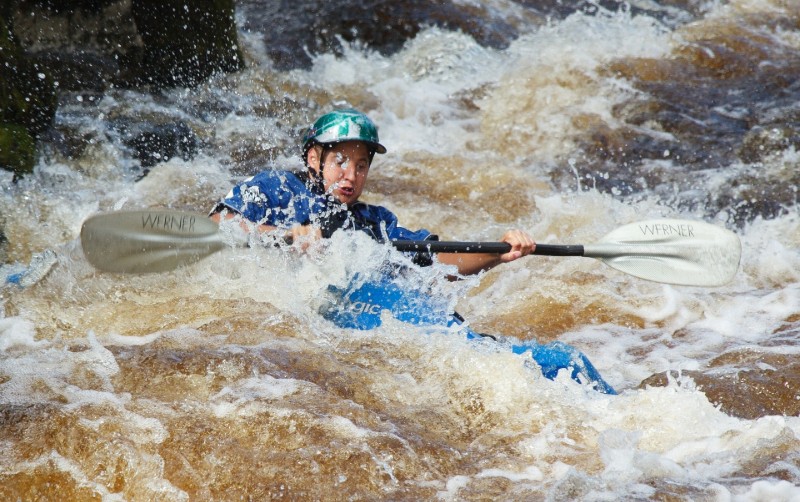If you’re preparing for a river kayaking trip, you probably already know what gear to bring to survive on the water.
If you’re a novice or someone who, like myself, is used to lake kayaking, you might need some tips for surviving in the water and on the shore should you lose your boat.
I thought I was prepared, but it took almost drowning for me to understand what I needed for survival.
Kayak camping is one of my favorite pastimes. This summer, I decided five days along the upper Colorado river would be the perfect way to spend my vacation.
Admittedly, I’m usually a flat water kayaker, but this stretch promised to be relatively smooth and calm with plenty of wilderness camping along the shores of our sixty-mile stretch.
Smooth it was not. Calm, definitely not.
This year was the highest water year Colorado has had in a very long time. Late season snow meant late season snow melt in high volumes and the river was running at 2700 CFS rather than its typical 600 CFS.
So, the long ambling stretches I was looking forward to turned out to be swift moving currents and roaring canyons.
Prior to our trip, we spoke with all the right people, did all the right research, and consulted with several guides local to that area who assured us we were properly equipped.
Well, despite our best efforts, we flipped our boats on the first day.
We spent the rest of our vacation attempting to recover from what was ultimately a life-threatening spill.
Launching the Kayaks
It began innocently enough. We decided to launch about two miles north of where we had originally intended to put in.
It was closer to where we had camped the night before and we drove along the visible portions of the stretch and didn’t see any signs of turbulence.
We consulted with the guides putting in at the launch point and decided to go for it. One guide confidently reassured us, “No rapids on this stretch, just smooth sailing from here.”
We launched our boats and were immediately concerned about the swiftness of the current. Before we had time to reconsider, less than thirty minutes into our float, we heard the sound of whitewater.
I tried to row to shore but the current was too strong and my boat too heavy, I was being pulled into Class III rapids and there was no way to stop.
I shouted over the current my kayaking partner, “Stay confident and keep your head above water!” I was whisked into the churning white caps of the boulder-laden rapids.
Whitewater Rapids in a 14′ Sea Kayak
I hit a pocket on the backside of a boulder and my kayak flipped immediately; the suction pulled me out of the cockpit and to the river bottom.
When I felt my feet make contact with the bottom of the boulder, I pushed off with every ounce of energy I had so as not to get pinned in the roiling current.
When I emerged, my kayak was starting to get away from me. It was heavy with water already, not to mention the gear, and floating upside down.
I put a hand on the rear of the hull and tried to keep my head above water. I kept my feet out in front of my body to deflect rocks and tried desperately to stay on my back while boulders and jagged bits of debris scraped against my knees, shins, back, and buttocks.
I began swimming toward the shore, slowly working my way diagonally and grasping at rocks along the shoreline.
My kayak was still gripped tightly in my hands, loaded down with five days worth of gear, food, survival supplies, and river water.
Suddenly, I felt the boat beginning to pull me away from shore toward the middle of the river again. I looked down stream, coughing and sputtering, only to see more white caps ahead.
If I held onto my boat I would be pulled into the next set of rapids and likely drown. I let the boat and all my gear slip from my fingers. I didn’t think about grabbing my emergency bag.
I didn’t think about anything, really, other than getting away from the meat grinder down stream.
A Breathless Escape from Yarmony Rapid
As the boat whisked ahead, I swam as hard as I could for shore. My nails broke and cracked against the rocky shoreline as I clawed for dry land.
Finally, and with great effort, I pulled myself ashore and stood on quaking knees to look for my kayaking partner.
I didn’t know it at the time, but I had just capsized in a fairly well-known rapid known as Yarmony.
In a whitewater or expedition raft, or in a river kayak at normal water levels, this stretch is actually kind of fun, or so I’ve been told. In a 14′ sea kayak at almost 3000 CFS, it was terrifying.
Looking back at the water from which I had just escaped, I saw my river partner. He was in the water clinging to his boat, heading into the second set of rapids that I had managed to avoid.
As I ran along the shore trying to keep up, my toes sticking out of my woefully shredded and inadequate water shoes, I watched him disappear under the white waves and around a bend in the river.
Those few moments running down the shore seemed like an eternity. Had he drowned? Would he be long gone after the bend? What was waiting around that corner, a waterfall? More rapids?
I rounded the bend to see him dragging himself and his water-logged kayak to shore, coughing and winded.
Relief flooded my senses and for a moment I didn’t feel any of the gauges, bruises, and cuts covering my body. I just felt happy. We had survived!
As we met along the shore, battered and bleeding, crying with relief, we started to realize the gravity of the situation.
Most of our gear was gone, what was left was soaked, and we needed help to get back to civilization.
Hitching a Ride Downstream
Thankfully, at that moment, a group of rafters were floating by.
They had successfully navigated the rapids we had just been dragged through and their much larger vessel had room for two more.
We gratefully accepted their offer of help and loaded our bruised egos and water-logged remaining kayak onto their aluminum-framed whitewater raft.
I explained to our rescuers that my kayak had been pulled downstream along with most of our gear and they calmly remarked I would get it back, probably in a few months when the water levels went down.
That’s when I realized we might have to make do with whatever supplies we had in my partner’s boat or whatever I had on my person.
Essential Survival Gear (or What Didn’t Get Washed Away)
Beyond your standard personal flotation device, medical kit, and water filtration system, these were some of the most important items we had on-hand for surviving the rest of the trip.
Mpowerd Luci Solar Lights
These lights are waterproof, lightweight, buoyant, inexpensive, and provide ample light for the campsite.
When I lost my kayak, we had four Luci lanterns and a set of Luci String Lights. Of those, we recovered two lanterns and the string lights. They were submerged for at least half an hour and still worked perfectly.
They recharge in just a few hours of sunlight and were indispensable.
Both our headlamps filled with water and broke (despite being stored in a reusable storage bag within a dry bag), so all we had for the remainder of the journey were the Luci lights and a Pelican flashlight.
Dry Bags
This may seem like a no brainer but quality dry bags truly would have saved our lives had we been on a more remote section of the river when we flipped.
Nearly all of our gear was stored in a variety of dry bags, ranging from inexpensive to top-of-the-line. Only two kept our gear completely dry.
The Watershed Chattooga Duffel performed the best. It’s rated for up to 300 feet of submersion and it’s made of a durable, puncture-resistant material.
It’s a pricey bag, but worth it. We stored our sleeping bags in this duffel so they were warm and dry – unlike most of the rest of our gear.
The other dry bag that outperformed the rest? A 14 dollar 40L Outdoor Products dry bag from Wal-Mart.
Its contents remained completely dry despite being submerged and dragged along a river bottom for several miles.
MSR Dragonfly
This little stove is awesome. It can burn multiple fuels including kerosene, unleaded auto fuel, diesel, and jet fuel.
We used white gas, which the Dragonfly used very efficiently. The kit comes with a fuel pump, windscreen, heat reflector, small-parts kit, instructions, and a stuff sack.
We brought a variety of food for the trip, but the only items that stayed dry were our canned goods. Needless to say, we ate a lot of soup the next few days.
Thankfully, the MSR was uncompromised by the moisture and provided us with fast and easy hot food. Plus, the windscreen protected the flame from strong afternoon winds.
It’s sturdy and holds a big pot (up to 10” in diameter), unlike most backpacking camp stoves. Further, we could use the white gas to start campfires with damp wood.
Garmin inReach Explorer +
When we were standing on the side of the Colorado river bruised and battered, we pulled out the water-resistant Explorer +.
This device acts as a satellite communication device, enabling text, GPS, and emergency services.
We had stored it in several zipper storage bags and tucked it into the pocket on my partners personal flotation device.
The zipper storage bags had not kept it dry during the long submersion (I’m as shocked as you are), so it was damp but functional.
I pressed the “SOS” button and watched the “cancel” button begin counting backward from five.
I cancelled it a moment before it sent the signal and decided to wait a few minutes, get my bearings, and decide if I really wanted to accept the monumental cost of a wilderness rescue.
Ultimately, we did not use the SOS feature and instead used it to send nightly texts back home to inform our families we were safe. It was reassuring knowing I had a way to communicate with emergency personnel as well as my family no matter where we were.
Worthless Gear (or What Not to Bring)
As much as we found some very helpful gear, we also discovered which items were useless or downright dangerous to rely upon. These items included:
Zipper Storage Bags
We thought, mistakenly, that if it can hold a quart of chili without spilling, surely it will keep your items fairly dry, or at least add another layer of protection within a dry bag.
We were so very wrong in this assumption. Rather than keeping things dry, these zipper storage bags allowed water in and then kept it there.
We pulled out so many zipper bags that were full of water – I felt like I had just won a goldfish from the fair.
Old Pelican Cases
Pelican cases are wonderful products. They’re well made, waterproof, and buoyant.
However, if they’ve been sitting in your dad’s garage for ten years, there’s a good chance that the rubber seals that make them so awesome are now cracked and useless.
This was our predicament, and again found that most items we stored in our old cases were floating in water.
An Emergency Bag
I naively thought if there were an emergency, I would deftly grab the emergency bag I had strapped to the top of my kayak before ditching the rest of my gear.
That was damn foolish. Anything you want to have if you lose your kayak should be on your person. There’s a reason life vests have pockets.
Resist the temptation to put some trail mix and a camera in those pockets!
A tiny waterproof medical kit, your Garmin inReach, a small water filter (Sawyer has some great options), a fire starter, a compass, a water-proof map, and maybe some calorically dense food should be strapped to your person in the event you become separated from the rest of your supplies.
The supplies you keep with you are up to you, but be sure they are located on your body so you don’t have to wonder where they are as you fight for your life in the water.
Important Takeaways
The real lesson here is to use a guide if you’re inexperienced and bring the proper gear to help you in an emergency.
We should have done that stretch with a guide at least a few times before expecting we could handle it on our own.
We put ourselves in danger and could have put emergency personnel in danger as well if we needed rescue.
As of August 2019, at least 21 people drowned in Colorado waterways in 2019. We could have easily made that number 23.
Please do yourself a favor, travel with guides and trusted experts until you’re intimately familiar with any stretch you intend to float and even then, come prepared for an emergency.
Have questions, tips, or advice? Leave a comment below!
This story is an extension of an article featured in the fall 2019 Outdoor Adventure section of Innovation & Tech Today. Get your copy at Barnes & Noble, Tattered Cover, or anywhere fine publications are sold.










